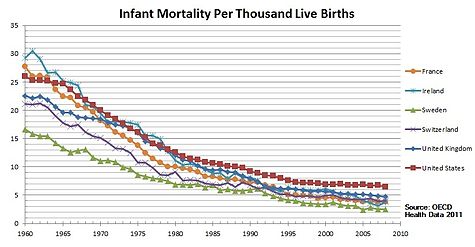Health in the Republic of Ireland
Appearance

- 47.6% of Ireland's population were covered by private health insurance, and 31.9% of the population were covered by Medical Cards.
- 23.8% of the population over 16 had a "chronic illness or health problem".
- 19.6% of the population over 16 had "limited activity", of which 6.6% were "strongly limited" and 13.0% were "limited".
- 47.2% of the population over 16 described their health as "very good", 35.7% as "good", 13.5% as "fair" and only 3.6% as "bad" or "very bad".
- 24.9% of the population over 16 were classed as smokers.
- There were 53 publicly funded acute hospitals, with a total of 12,094 in-patient beds available and 1,253-day beds available.
Vaccination
In the Republic of Ireland, childhood vaccination (up to age 16) requires the consent of the parents. The Department of Health strongly recommend vaccinations.[3]
See also Healthcare in the Republic of Ireland
References
- ^ "Archived copy" (PDF). Archived from the original (PDF) on 20 November 2007. Retrieved 2008-01-27.
{{cite web}}: Unknown parameter|deadurl=ignored (|url-status=suggested) (help)CS1 maint: archived copy as title (link) - ^ "Archived copy" (PDF). Archived from the original (PDF) on 11 April 2008. Retrieved 2008-02-24.
{{cite web}}: Unknown parameter|deadurl=ignored (|url-status=suggested) (help)CS1 maint: archived copy as title (link) - ^ "Immunisations for children and young people". Citizens Information. Citizens Information Board, Republic of Ireland. 16 September 2014. Retrieved 24 April 2015.
